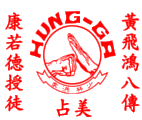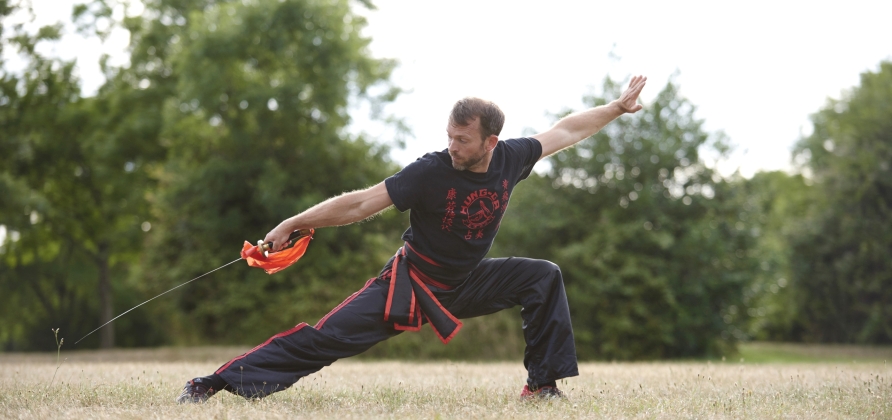Our Lineage
The lineage of Yee's Hung Ga can be traced all the way back to the Shaolin Temple.
Abbot Gee Sin Sim See passed his teachings on to several students, one of whom was Hung Hei Guen. Hung Hei Guen formally founded the Hung Ga style in the early 1700s. Below, our lineage from Hung Hei Guen's disciple, Luk Ah Choi, onwards.











Luk Ah Choi – 陸亞采
Luk Ah Choi was the son of a Manchu stationed in Guangdong. After his parents died, he was brought up by his uncle but ran away when he was 12 years old, because his uncle was abusive. He met a monk named Lei Baak Fu, a master in the Southern Fa Kuen (Flower Fist), and became his student. After 7 years of training, Lei Baak Fu sent him to the southern Siu lum Temple in Fukien Province, where he became a student of Abbot Gee Sim Sim See. After the destruction of the Shaolin temple, Luk Ah Choi went back to Guangdong, where he devoted himself to Martial Arts and Chinese Medicine until his death at the age of 68.

Wong Kei Ying – 黄麒英
Accounts of Wong Kei Ying’s training history differ. Some say that as a young boy he earned a living as a street performer. During a performance he was noticed by Luk Ah Choi and became his disciple. Another story tells that Wong Kei Ying learned from his father Wong Tai, who was a student of Luk Ah Choi. Later, Wong Kei Ying was sent to Luk Ah Choi to continue studying under his guidance.
It is widely accepted that Wong Kei Ying later became the martial arts instructor of the general of Guangdong’s infantry regiment and gained fame as one of Southern China’s famous Guangdong Sup Fu (Ten Tigers of Canton). He exchanged a great deal of knowledge with other Kung Fu masters, such as Wong Yan Lum, a “Lion’s Roar” Kung Fu master who was also one of the Ten Tigers.
Wong Kei Ying was also a well-respected doctor and he often travelled across China along with his son, Wong Fei Hung, to find and bring back herbs and medicine to his clinic in Guangdong. During these travels, he met and trained with many famous Kung Fu masters of the time. It is said that during one of their journeys, Wong Kei Ying helped to heal a man who was injured while watching a Kung Fu exhibition. The performer who accidentally injured the man was Lam Fuk Sing, a top student of the famous Tiet Kiu Sam. Lam Fuk Sing was so grateful for his help that he taught both Wong Kei Ying and the young Wong Fei Hung the famous internal form of Hung Ga: Tiet Sien Kuen.

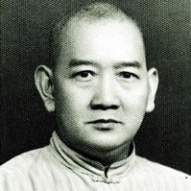
Wong Fei Hung – 黄飞鸿
Wong Fei Hung is a charismatic figure who has been portrayed in over 100 movies, played by many great actors, such as Kwan Tak Hing and Jet Li. The real Wong Fei Hung was born in 1850 in Guangdong. His father was Wong Kei Ying, one of the earlier Ten Tigers of the late Ching Dynasty. Wong Fei Hung was one of the later Ten Tigers.
Both Wong Kei Ying and Wong Fei Hung were inducted into the “Ten Tigers” while they were still in their early twenties, while the other eight Tigers were all at an advanced age and of a higher Kung Fu generation. This showed great respect and honoured the Wongs by indicating that their skills were comparable with the Sifus of a higher generation.
Wong Fei Hung began his martial arts training at the age of five and by the age of thirteen he was already an accomplished martial artist. He often went out with his father to demonstrate Kung Fu and sell medicine in different villages. On one occasion a famous teacher of another style, Sifu Gwan Dai Hung, was demonstrating on the same day. He became jealous because the Wongs had a much larger crowd watching their performance. Every time he demonstrated his famous left handed fishing pole techniques the size of the crowd would be unmatched. Sifu Gwan felt that they were invading his territory and, with pole in hand, he approached Master Wong Kei Ying to challenge him to fight. Master Wong smiled and told Wong Fei Hung, thirteen at the time, to take up a pole and match skills with this Sifu using the Ng Lung Ba Gwa Gwun (Fifth Brother Eight Diagram Pole) techniques. Wong Fei Hung defeated the challenger and the word spread far and wide. Even though still a child, he was a great fighter. This incident started young master Wong’s fame.
Wong Fei Hung is credited with formalizing the orthodox Hung system and creating the style’s most famous set, the Fu Hok Seung Ying Kuen (Tiger Crane Double Pattern Fist). According to Master Frank Yee’s Grandmaster, Tang Fung, the tiger-crane set was developed from Tiet Kiu Saam’s horse stance and hand bridge combined with Wong Fei Hung’s fighting techniques. In fact, the Hung system’s strength was in the tiger/crane techniques, the twelve bridges, horse stance and Wong’s secret Sup Juet Sao (10 Killing Hands), which was only taught to “in the door” disciples.
Wong Fei Hung was also famous for the Tiger Tail Kick & Mo Ying Gerk (Shadowless Kick). Many believe that Wong Fei Hung invented the Mo Ying Gerk, but he learned it from a famous Sifu called Song Tong Fai. There is a story that Sifu Song was staying at a hotel where at night he used to practice in the courtyard. One evening he heard a woman laughing, he turned and asked the woman “Why are your laughing?” She said “You only have hands with no kicks”. He couldn’t believe this woman would say this. Sifu Song asked the woman to show him and they sparred. Every time he made an advance within striking distance, he would be kicked but he never saw it coming. Afterwards, he got to know and eventually married the woman and learned this skill from her. Wong & Song were friends, Song wanted to learn the Tiet Sing Kuen and Fook Fu Kuen and Wong wanted the Shadowless Kick. They exchanged and the Hung system then inherited a new technique.
As an adult he taught martial arts to the navy in Canton and held a position in the General’s office. Wong Fei Hung eventually left Canton and moved to Fukien to become General Tong Gin Cheung’s right-hand man. General Tong was a fighter for the resistance to the Ching Dynasty. The resistance eventually collapsed and Wong moved back to Canton to teach Hung Kuen and to establish the Po Chi Lam medicine shop. Wong was undefeated throughout his life, and produced many famous students and disciples, some of which are:
- Liang Foon - His top disciple, famous for cracking the ground under his feet when he sat in a horse stance.
- Ling Wan Gai - Famous for his “Gwai Gerk” (Ghost Kicking) skills.
- Chan Din Biu
- Lam Sai Wing - Famous for his sabre techniques and writing three books on Hung Ga.
- Tang Fung - famous for his strict, rigorous training and his stubborn “Old Square Mind” mentality.
- Sui Low Ngan
- Sui Low Yuk
- Tak Gan Jow
- Luk Jin Gun
Wong Fei Hung was not only good at martial arts but also had exceptional Mo Duk (martial virtue) and medicine. During the late Ching Dynasty he owned two herbal shops, one in Canton and the other in Futsan. At his Po Chi Lam herbal shops, he would make his own Dit Da medicine which became very famous, leading him to be known as one of the four top doctors in Southern China, still remembered today:
- Wong Fei Hung
- Jow Hong Gon
- Lei Gam Chuen
- So Hut Yee
During his lifetime Wong Fei Hung had four wives. There is a funny story about how he met his 4th wife Mok Gwai Lan. Madame Mok Gwai Lan, also known as the “tigress” was watching a lion dance and Kung Fu demonstration during a celebration day for the Buddha in Fatsan. Mok Gwai Lan, 19 yrs old, and already an accomplished martial artist herself, wanted to see first-hand this famous man whose reputation preceded him. While Wong was demonstrating the Yu Ga Dai Pa (Yu’s family Great Fork), he kicked and his shoe flew off and hit her in the face. Mok Gwai Lan jumped on the stage and struck Wong Fei Hung in the face and Wong’s students were infuriated. Mok stated that “This time it’s your shoe, but what if the next time it’s your weapon. You could kill someone. A person of your skill should never have an accident like that.” Wong just smiled and said, “You are right I should not have been so careless.” Mok Gwai Lan disappeared into the crowd but Wong Fei Hung had fallen in love: a woman that strong would certainly make a good wife. He searched for her and eventually found and married her.
At the end of the Ching Dynasty and the founding of the republic in 1912, Wong Fei Hung became the head instructor of martial arts for the Special Forces elite military unit, under the direction of the General Lau Wing Fuk in Canton City.
In October of 1924 there was a strike against the government by all the businesses. Canton city fell to riots and Wong Fei Hung’s home and herbal shop were burnt to the ground. He lost all his belongings and money. Later on, his son Wong Hawn Sum lost his job and was shot dead in an altercation with a drug gang. After all this, Wong took ill and died in his home in 1933 at the age of 83. His wife moved with their sons to Hong Kong and taught Hung Kuen there. She also produced many famous disciples.

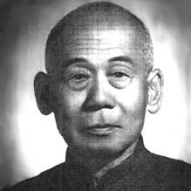
Tang Fung – 鄧芳
Tang Fung was one of Wong Fei Hung’s most famous disciples. He was born in Sam Soy village in Guangdong in 1874. In his youth he studied old-style Hung Ga under Sifu Wong Yau and Sifu Yuen Yin, as well as Mao Shan, a form of folk sorcery. Later he learned the new Hung Ga from Wong Fei Hung and became a close disciple.
Tang Fung was a participant in the Luk Sin theatre incident where Lam Sai Wing, Tang Fung, Tang Yee, Gwan Kwan, and a few of Lam’s disciples famously became trapped by a rival instructor at the theatre. The rival led an attack with about eighty men, heavily outnumbering the group of no more than ten with Tang Fong. They sustained a few minor injuries, and all eighty people of their opponents were sent to the hospital. Tang Fung, his brother Tang Yee, and Lam Sai Wing left town to avoid retributions and further trouble. Lam Sai Wing went to the Guangdong/Gwongsai border and Tang Fung went to Malaysia to supervise a tin refinery. Later Tang Fung returned to Guangdong.
After Wong Fei Hung was quite old, Tang Fung and his brother Tang Yee opened a school called the “Yee Yung Tong” (Chivalrous Brave Hall). After Wong’s Death, his wife Mok Gwai Lan taught an all women’s class at Tang Fung’s school.
After the start of the Sino-Japanese war in 1937, Tang moved to Hong Kong where he established a medicine shop at Sum Soi Bo and helped many people. He was said to always having a good heart and never charge for treatments if someone could not afford it. Tang Fung also married twice, but his second wife, Ho Fan, was the one Tang’s students called Simo. Ho Fan was taught the Ji Mo Seung Dao (Mother & Son Double Swords) and often demonstrated in fighting sets with Tang. Tang lived in Kowloon, Wang Gok, But Lan Street. He taught six days a week, even when he was in his seventies. He taught 3 days on the Kowloon side at the jewellery association, and then take a one-hour ferry on alternating days to the Hong Kong side to teach at the Shau Kay Won Fish Market Association. He also took over the position as head of security from Lam Sai Wing at the fish market. During his years in Hong Kong, Tang Fung established a strong reputation for himself. His teaching was known to emphasize hard stance training and strict detail to forms and applications. He was nicknamed “Lo Wan Ku” which means “Old Square Mind”, a reference to his stubborn traditionalism.
Tang Fung’s daughter, Tang Sou Kin, broke from his traditionalist outlook and was heralded as Queen of the Lion Dance during the 1920s. At that time women were not usually allowed to participate in lion dance, for which Tang Fung was well known. During the early 1950s, he performed a special performance lion dance for Queen Elizabeth.
Tang Fung produced many well-known students & disciples:
- Yuen Ling - Successor to Tang Fong, represented in the U.S. by Master Yee Chi Wai.
- Lau Kai Ton - Represented in the U.S. by New Mexico’s Master Frank Rivera.
- Luk Gan Wing - Represented in Ontario, Canada by his son.
- Wong Jo - Who can be found at the Shau Kay Won Fish Market Association, HK.
- Ho Lap Tin - Represented in the U.S. by Philadelphia’s Master Cheurng Shu Pui.
- Cheung Tai Hing - Represented in the U.S. by New York’s Master Wan Chi Ming.
- Jao Wing Duk - Represented in Spain by Master Lam Chuen Ping.
- Kwan Kei Tin
- Won Lei
Tang Fung was also famous for a weapon that was not a standard Hung Ga weapon: the Ngauh Gwat Sin (Beef Bone Fan) or Iron Fan techniques, which became renowned in Hong Kong, although his skill was rarely demonstrated.

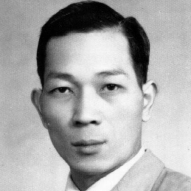
Yuen Ling – 阮凌
Yuen Ling was born in 1921 to a large family in Sun Wui, Guangdong. In the depression, his family lost its fortune and he went to Fatsan with his older brother, to make a living peddling food from a pushcart at the railroad station. There were plenty of other food vendors and disputes were settled with force more often than not.
Deaths were not uncommon, but Yuen Ling was known for his Kung Fu skills and was able to establish an important position for himself within the vendor community.
At the railroad station, Yuen Ling studied old-style Hung Ga Kung Fu under a Sifu nicknamed Sau Gau (Skinny Dog). Old Hung Ga is the style that was not from Wong Fei Hung. During the 1940s, with China engaged in World War II, Yuen Ling escaped to Hong Kong and settled in at the Shau Kai Wan Fish Market to make a living. Like the Fatsan railroad station, only the strong survived the competition, and it was here that he met Tang Fung. He became Tang Fung’s last disciple and learned Hung Ga and Dit Da medicine. Being a strong-willed, intelligent and capable person, it was not long before Yuen Ling established himself as the top person at the fish market, controlling all of the seafood distribution throughout Hong Kong.
During this period, he also established a school at Main Street East, where he taught Hung Ga Kung Fu and treated patients at his clinic. Yuen Ling was legendary for his skills in negotiation and settling disputes for his students, neighbours, and friends. He would often attend these negotiations alone, carrying nothing save the iron whip-chain he wrapped around his waist. He would sit down with the opposition to discuss the issues and if the negotiation did not go well, he would settle the matter with force.
Yuen Ling was an accomplished lion dancer, well known for his Ngauh Chat Sau Dai Si. His black lion head was famous throughout Hong Kong for its run-ins with other lions and dragons. He never lost during these encounters, always emerging victorious. He also won many Cheurng Pao contests.
Due to the strain of running both the fish market and the Kung Fu school while suffering from stomach cancer, Yuen Ling’s health took a turn for the worse. He died in 1966 at the young age of 45. On the day of his funeral, martial artists from all over Hong Kong, as well as members of the law enforcement and underworld communities came to pay their respects. It was one of the largest funeral processions in Hong Kong’s history.

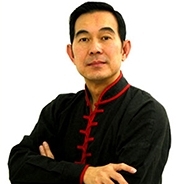
Yee Chi Wai – 余志偉
Grandmaster Yee Chi Wai (Frank Yee) started his Kung Fu training with his father at the age of six under the tutelage of Grandmaster Yuen Ling. Master Yee immersed himself in his Hung Ga training and studied intensively under the watchful eye of his Sifu. After years of dedicated studying, he was rewarded with the Bai See ceremony and became a disciple to his Sifu.
Of all the disciples of Grandmaster Yuen Ling, only Frank Yee has dedicated himself to teaching Tang Fung Hung Ga.
Master Yee also studied Dit Da medicine under Doctor Sit Chuk Sing, famous for his medicinal skills and whose family was renowned for having been personal physicians to the Ching dynasty Emperor of China for four generations.
In 1968, Master Yee emigrated from Hong Kong to Montreal, Canada, and soon after went to Toronto to earn a Mechanical Engineering degree from George Brown University. During this period in Canada, in addition to working and going to university, he taught Hung Ga Kung Fu at George Brown University, the Jong Ting Association, and the Hung Moon Association.
In 1973, Master Yee arrived in New York City’s Chinatown and established Yee’s Hung Ga Kung Fu Academy, where he taught as well as at Long Island University and Columbia University. With over thirty years of teaching experience, he currently has students all over the world, with branches in China, Europe, Canada, the United States and South America. Over the decades, Yee’s Hung Ga has competed in numerous local, national, and international tournaments, winning thousands of medals including over a thousand gold medals.
Master Yee was one of the founding fathers of the Eastern United States Kung Fu Federation and has served as its President, Vice-President and Secretary. At the request of the Toisan City government in China, he is currently the President of the Toisan Kung Fu Association, overseeing martial arts activities for the city. He also serves as an advisor to the Wong Fei Hung Museum in Fatsan, as well as the coach of the museum’s Traditional Kung Fu Division.
Master Yee has spent the past several years immersed in his training and raising his consciousness of what Hung Ga Kung Fu can be. It was also during this time that he created the Toisan City Toi Sing Kung Fu Association where he teaches traditional Southern Kung Fu and Lion Dance. Master Yee accepts only those students who show a commitment to learning and who are of high moral character. He provides living quarters, equipment and training to various students free of charge. Through this school, he works to revive traditional Southern Kung Fu in China facing the increasing popularity of Wushu. It is due to his dedication that the people of Southern China are being reintroduced to and are embracing traditional Kung Fu once again.
To spread Wong Fei Hung’s Hung Ga and traditional Kung Fu, Master Yee inaugurated the Wong Fei Hung Northeastern All Kung Fu Championship tournament in 1996. It has grown each year, attracting over 500 competitors from all over the United States, Canada, Europe, South America and Asia. The tournament has over 136 divisions including traditional Kung Fu, modern Wushu, Sparring, Shuai Jiao, Ba Gua and Tai Chi.

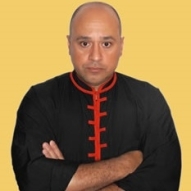
Master Pedro Cepero Yee (Sifu Level, 8th Dan) was introduced to martial arts at age six with a local Filipino family who taught their native arts. At ten years old, he formally began to study the arts of Karate, Shuai Jiao, Wing Chun and his chosen art, Hung Ga Kung Fu. Pedro Cepero Yee is a well-respected member of the Chinese martial arts community in the U.S. and abroad.
He has demonstrated his skills in performance, as well as seminars and classes across the U.S., Canada, Bermuda, Bahamas, Puerto Rico, Scotland, England, Germany, Trinidad, Malaysia, Hong Kong, and the Peoples’ Republic of China. He is the eighth Senior Yup Sut (In the Room) Disciple of Grandmaster Yee Chi Wai, as well as one of the first Americans to be accepted into the Yee’s Family Lineage at the New York Chinatown’s Yee Fong Toy Association and their world headquarters.
Sifu Pedro Cepero Yee also has extensive training in Traditional Dit Da (Traumatology Medicine), Tuina-Chinese Bodywork Therapy and Swedish Massage therapy. He assisted and apprenticed in Dit Da Medicine under his Sifu in his New York Chinatown Clinic during 1987-1991. He studied Tuina formally with Bill Helm, ABT, (TS–Dean of Allied Arts, Pacific College of Oriental Medicine, and Director of the Taoist Sanctuary of San Diego) as well as Western Swedish Massage at the Helma Institute of Massage Therapy. This training earned him the national designations of “Diploma of Asian Bodywork Therapy (NCCAOM)”, “Certified Practitioner (AOBTA)”, and “Nationally Certified Massage Therapist (NCTMB)”.
After many years of working closely together, Grandmaster Yee Chi Wai and Master Pedro Cepero Yee agreed that their relationship had transcended that of teacher and student, to become more akin to father and son. To openly reflect this realization, Pedro A. Cepero’s name was legally changed by the courts of the state of New Jersey to Pedro Cepero Yee on September 19, 2003. This good news was made public in a joint announcement at the 2003 North Eastern Wong Fei Hung All Kung-Fu Championships held in Hackensack, New Jersey.
Master Pedro Cepero Yee currently teaches and practices Hung Ga Kung Fu and Tuina as well as conducting ongoing workshops in the United States and the UK. He is also a well published author on Hung Ga Kung Fu. His article, “Hung Ga from Canton to New York”, is permanently on display at the Wong Fei Hung Museum, the ancestral home of the style in Foshan, China. He was the first non-Asian person to appear on the cover of the Hong Kong Magazine “New Martial Hero (Autumn 2005) after 35 years of publication. He is also featured on the cover along side his Sifu in “Kung Fu Tai Chi Magazine” (May/June 2006).

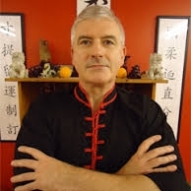
Bruce Clark – 布仕
Sifu Bruce Clark, 6th Dan, began his martial arts training at the age of 11. Since then he has studied; Judo, Lau Gar Kung Fu, Freestyle Karate, Tae Kwon Do, Goju Ryo Karate and his chosen art of Hung Ga Kung Fu.
Whilst living in the U.S. for ten years, Sifu Clark studied Hung Ga Kung Fu under Master Pedro Cepero Yee.
During this time, Sifu Clark was a familiar face in the Martial Arts community taking part in Lion Dances and demonstrations, including Chinese New Year in New York’s Chinatown.
In addition, Sifu Clark placed in many tournaments across the U.S., culminating in a national number two ranking for Lei Tai full-contact stage fighting.
In November 2002, Sifu Clark was given the title of Scottish Sanshou fighting coach for the British Council for Chinese Martial Arts, the official Sports Council recognised governing body for the UK. The Aberdeen branch of Yee’s Hung Ga has been running successfully for over ten years.


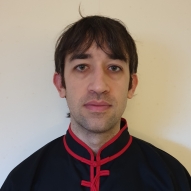
Conrad Barrett-Freeman – 庚若德
Sifu Conrad Barrett-Freeman, 4th Dan, began training under Sifu Thomas Stefanou in September 2005 and became the chief instructor in Edinburgh in 2009.
He has been learning directly under Grandmaster Yee Chi Wai since 2012 and regularly visits China for detailed instruction on Hung Ga Kung Fu, Lion Dance, Dragon Dance, Medicine and Philosophy.
Sifu Conrad Barrett-Freeman became a Yap Moon (In the door) disciple of the lineage in June 2014.

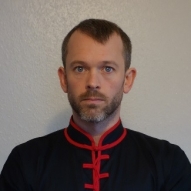
In 2008 Jim encountered the Yee’s Hung Ga School in Edinburgh, and his search was over. Initially under the tutelage of Sifu Tom Stefanou, and later Sifu Conrad Barrett-Freeman, Jim developed a passion and deep respect for the system.
He achieved the rank of Jo Gow in 2015 and 1st Dan in 2016. In 2016, he established the Bristol branch of Yee’s Hung Ga International Kung Fu Academy, the first in England.
Jim has travelled widely, and has lived in Latin America and China. He works internationally as a research scientist in sustainable development, and holds a PhD in Agriculture. He lives on a small farm outside of Bristol, with his wife and two daughters.

